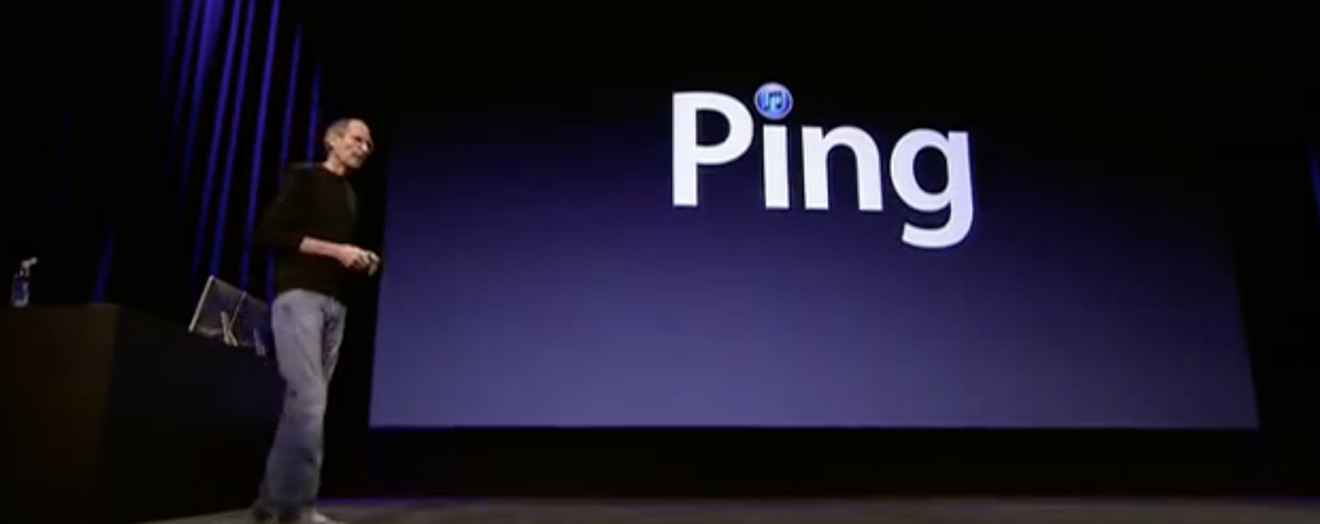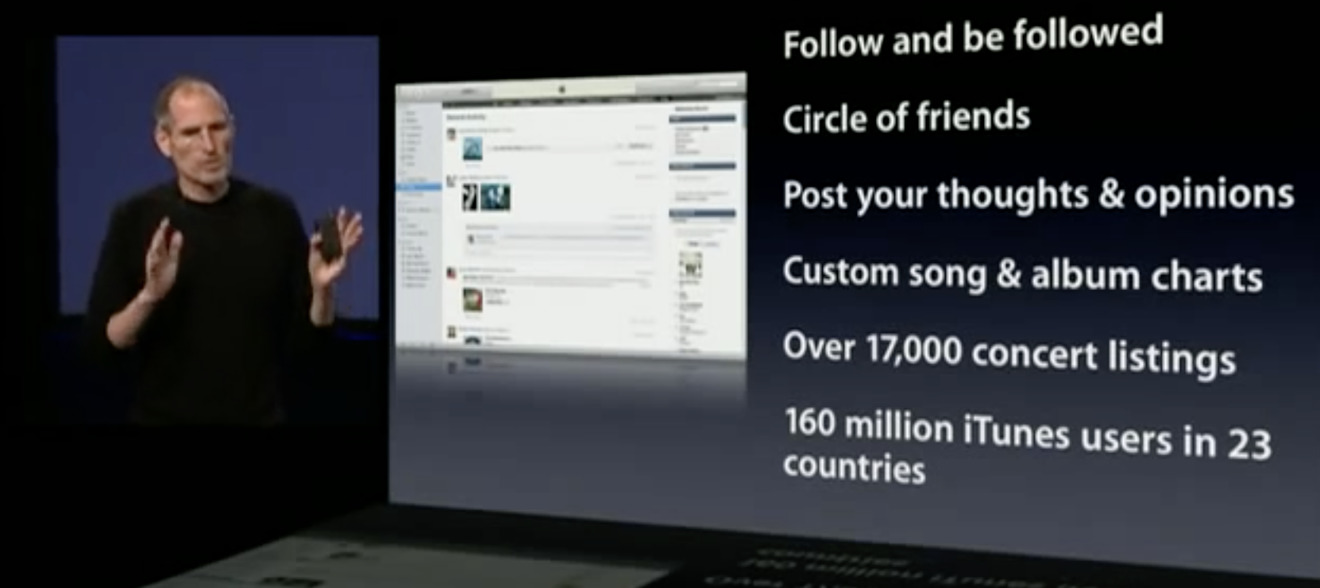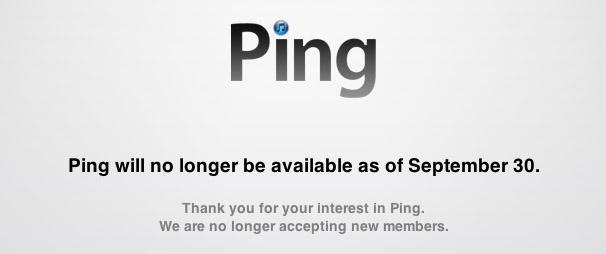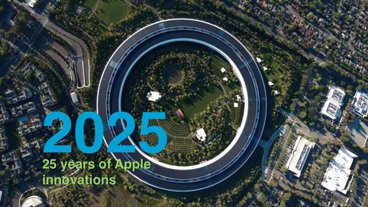Back in 2010, Apple was riding high on the iPod and iTunes Music Store but it was missing out on social media. Enter Ping, a music-based network that faltered from the start and was dropped two years later. AppleInsider looks at what went wrong — and also what few aspects went right.
The iPhone was a monster hit and the iPad had just been introduced. At the same time, Facebook and Twitter had emerged as major forces, especially as we were all switching from computers to cellphones and apps as our primary devices. Apple responded to this trend by launching a social network of its own, called Ping.
Ping was launched on September 1, 2010, as part of iTunes 10. Steve Jobs, four months before his final leave of absence from Apple, introduced Ping at the keynote event, which also featured the introductions of a new iPod lineup and the second generation of Apple TV.
"What Ping is," said Jobs on stage, "is sort of like Facebook and Twitter meet iTunes. It's a social network all about music."
The idea was that iTunes users, through this built-in Ping feature, could follow their favorite artists. They could also find out what music their friends were enjoying plus which concerts they were attending. In addition to reading the posts by artists and friends, you could also see a Top Ten chart that Ping automatically compiled based on the popularity of songs and albums in the accounts you chose to follow.
This ability to follow people sounds similar to Twitter and Facebook but it was a blending of the two. You could follow any artist or friend you want, but people could only follow you if you allowed them. This was meant to help you create what Apple called "circles of friends". However, it was also a limitation and Jobs seemed to acknowledge that when he went on to say that he expected all music artists would choose to automatically approve any follower.
Many artists were involved with Ping at the start. Coldplay frontman Chris Martin performed at the event, while Lady Gaga endorsed Ping via video.
Two days after the keynote, Apple announced that one million users had signed up for Ping in the first 24 hours. iTunes required users to opt in to Ping, and while one million sounds like a lot, iTunes had 160 million users worldwide at that time.
Early signs of trouble
Ping suffered from bad press right at the start. Jobs, in an interview the day after the keynote with Kara Swisher of the Wall Street Journal revealed that the plan had been to integrate Ping directly with Facebook. He said that this had failed at the last minute and he blamed "onerous terms" demanded by the social networking giant for the lack of a deal.
Later that month it was revealed that these negotiations with Facebook had gone on for 18 months.
While you have to imagine that an integration with Facebook, then definitely in the ascendant, would have helped Ping, there was also trouble with what did join the service. In the opening days, Ping was plagued by spam, as well as bogus accounts for Jobs, Jony Ive, and various musical artists, including singer Ben Folds.
Early reviews were also less than stellar, with many observers knocking Ping for that lack of integration with existing social networks.
More technical people even disliked the name for how it rhymed with Bing, the Microsoft search service.
While it would never get Facebook involved, Apple would end up adding Twitter integration in November 2010. In the next month it offered an exclusive song from that year's posthumous Michael Jackson album Michael. This is the album that was later alleged to contain fraudulent Jackson tracks but Apple's one, Much Too Soon is not one of them.
The forgotten network
Over the next year, Ping rather petered out with no updates or further free albums. Jobs did keep trying to get Facebook involved — he personally invited Mark Zuckerberg to discuss it over dinner — but it became clear that very few people were actually using the service.
Perhaps Jobs would've continued to push Ping but shortly into 2011, he announced a leave of absence from Apple. He would the resign in August and die in October. When Tim Cook then took over as CEO, it looked obvious that Ping wasn't long for the world.
The Death of Ping
Ping's actual demise dragged out for several months, though. In a May 2012 interview, with Swisher and Walt Mossberg, Cook vowed to make Apple more social. He stopped short of announcing Ping's death but did say that: "we tried Ping and I think the customer voted and said this isn't something I want to put a lot of energy into."
"Will we kill it? I don't know. We'll look at that," Cook added.
Shortly after on September 12, 2012, Apple announced that Ping would close at the end of the month.
The network was formally taken offline September 30, 2012, just over two years after its launch.
The Ping Legacy
There were perhaps a few key reasons why Ping failed. It didn't give users much that they weren't already getting from other social networks, for instance. In now what seems a peculiar idea, Ping encouraged sharing but not of entire songs, only of snippets. It would recommend music to you but only based on what you'd specifically bought from the iTunes Store. So it was limited and together with the spam and fake accounts, Ping didn't make a good first impression.
Apple, of course, would change its music business model radically, with the launch of Apple Music in 2015. It was a new and really in all ways better service but it did borrow some of the more successful elements of Ping and continues to add more.
Right from the start, Apple Music contained a feature called Connect which was meant to provide the benefits of Ping's system of following artists. It's still in Apple Music today, though anecdotally it doesn't appear to have had giant success.
More recently in August 2018, Apple Music effectively reintroduced Ping's listing of songs your friends are listening to. The Friends Mix now sits alongside the familiar Favorites, New Music and Chill mixes.
Ping is mostly remembered these days as a curiosity, and as the last of the products in the Steve Jobs era to go down as a failure.
Looking back on it, though, it's curious to see that its cluttered interface now looks like a presage of the way Facebook and other social media successes would go. Perhaps in that sense it was ahead of its time but really the lesson here is in how very hard it is for any company to launch a successful social network.
 Stephen Silver
Stephen Silver









-m.jpg)






 Marko Zivkovic
Marko Zivkovic
 Christine McKee
Christine McKee
 Andrew Orr
Andrew Orr
 Andrew O'Hara
Andrew O'Hara
 William Gallagher
William Gallagher

 Mike Wuerthele
Mike Wuerthele
 Bon Adamson
Bon Adamson




-m.jpg)



15 Comments
...And haters called Apple Music Ping 2.0.... Not even close.
The headline also calls this a "music service" but I believe it was a social network with a focus on music.
I think the theory behind the service was fine, just the implementation faulty. Like with Apple Music they should have had the option to follow or share but not make a huge deal of it.
The problem with ping is it wasn’t a good idea. It was too focused and was more of a feature than a service. It was like a worse version of Twitter. I said it from the beginning, from the time it was launched, Ping should have been a column button in iTunes for every song and in one click it would tweet your now paying song title with a link to Twitter and post it to Facebook. So it’d be no more than a convenient way to tell your friends what’s now playing in your iTunes. Nothing more, nothing less. That’s all Ping should have been. An iTunes feature. Not a limited crappy social network.
I don’t know, I actually liked Ping. It did all I was actually after. It allowed me to follow artists I was interested in and get updates on what they were up to so I knew about new albums, concerts etc. The “social” aspect with friends was never of any interest to me, which is also why I have not done the same with Facebook and don’t use Twitter etc.